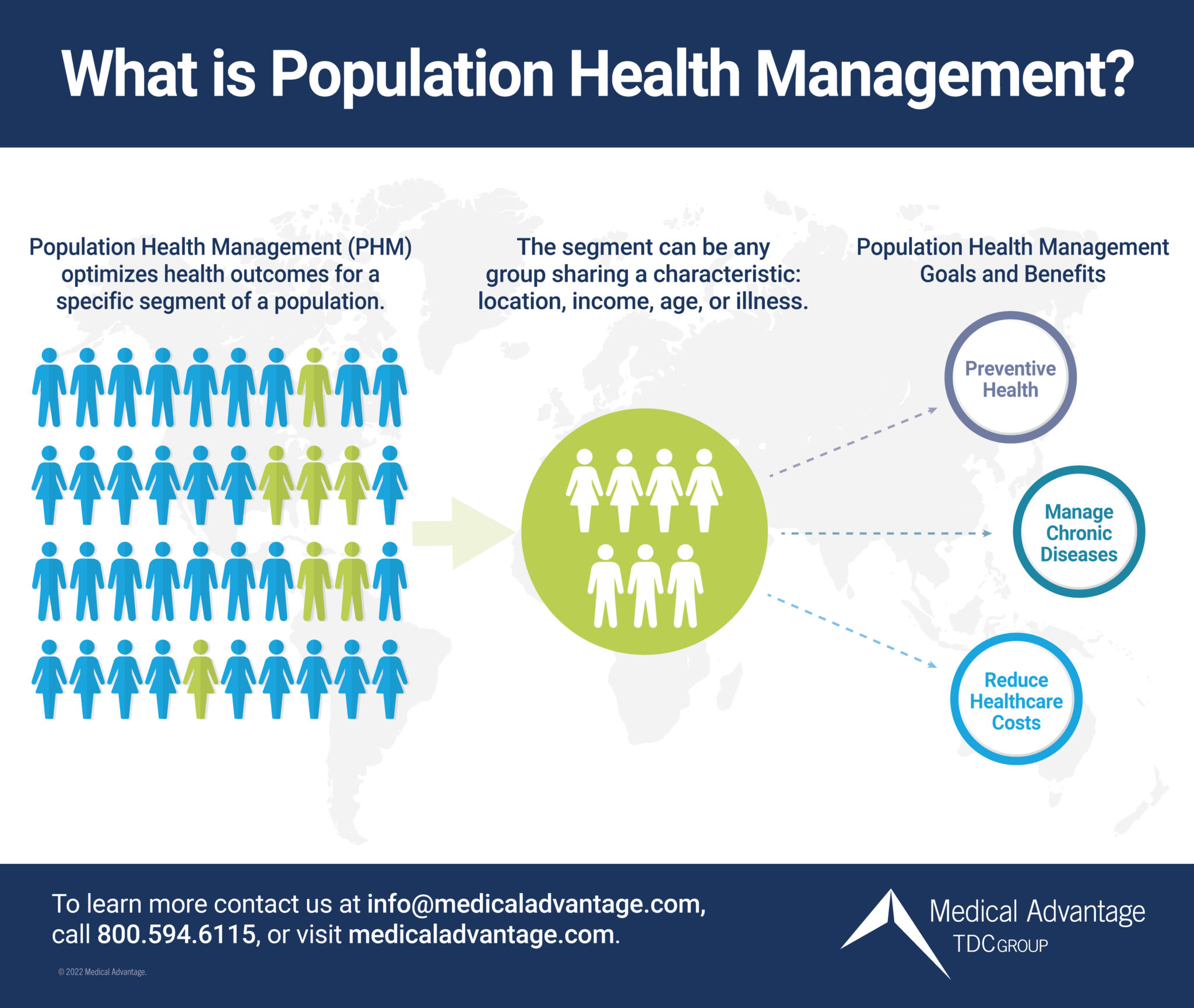When it comes to working in healthcare there are plenty of challenges and concerns to solve. How can I serve my patients more effectively? How do I help manage chronic diseases or keep my patients engaged in preventive health? How can I possibly keep costs down? Population health management (PHM) may be the answer.
What is Population Health Management
Population health management (PHM) refers to the optimization of health outcomes for a defined segment of the population, including the distribution of such outcomes within the group. The segment of the population can refer to any group of people that share a characteristic, such as location, income, age, or specific illness.
For example, when a healthcare organization helps determine the best way to provide prescriptions to patients at risk of heart disease – they’re participating in population health management.
The earliest accepted use of the term dates to 2003 when David Kindig, MD, PhD, and Greg Stoddart, PhD wrote a paper titled What is Population Health Management.
At the time, the idea of PHM was relatively new. And Kindig and Stoddart wanted to create a discussion within the medical community to determine a consensus definition. Kindig and Stoddart argued that “the field of population health includes health outcomes, patterns of health determinants, and policies and interventions that link these two.”
Since Kindig and Stoddart’s attempt to nail down what PHM really meant, the definition has continued to evolve alongside technology and healthcare’s continued shift towards value-based care.
Today, PHM isn’t possible without the heavy use of data analytics. Here’s a more recent description of population health management in our modern healthcare world via Health IT Analytics, “Today, population health management” can perhaps be better described as “the process of using big data analytics to define patient cohorts, stratify members by their risk of experiencing certain events, deliver care targeted to the individual needs of those members, and report on individual and group outcomes to ensure quality and accountability.”
The definition of PHM has changed since the idea was first introduced to help encapsulate its goals and benefits, as well as the processes by which organizations reach those goals.
What are the Goals and Benefits of Population Health Management?
The goals and benefits of population health management are one in the same: preventive health that pre-empts issues, chronic disease management that improves quality of life, and improvements in those areas that reduce costs.
Improved patient care and reduced costs are the primary benefits of any organization that intentionally implements PHM practices. So, what are some of the ways that PHM programs make progress towards these goals?
Preventive Health
One of the tenets of the PHM model is delivering healthcare in a proactive manner rather than a reactive one. Healthcare organizations can cut costs by providing services today that take measures to keep patients healthy for the long term, thus lowering the chance they’ll need serious medical attention in the future.
Some examples of preventive care initiatives include blood pressure, diabetes, or cholesterol tests, which can prompt patients to make lifestyle changes or doctors to prescribe necessary medicine.
When healthcare organizations perform such tests, they gather useful information on their patient population. This can help the organization determine which populations are most at risk for certain diseases or illnesses, allowing them to more efficiently focus their efforts.
It can also help direct public health education initiatives toward groups that may be vulnerable. We’ve probably all experienced various campaigns communicating the dangers of smoking, drugs, and alcohol from healthcare organizations, as well as the importance of staying active. This education of the public on the best ways to stay healthy is one of the most effective ways healthcare can engage in preventive care.
One example of this type of public education is the This Girl Can Campaign which promoted more exercise among women. The organization’s research showed that women may not prioritize exercise due to a fear of judgment and their campaign sought to rectify that. The message was simple, empowering, and effective: “there’s no ‘right’ way to get active. However you jiggle, kick, lift, stretch, or sprint, it’s time to get moving.” Since 2015, the campaign has persuaded 4 million women to exercise more.
Chronic Disease Management
According to the Centers for Disease Control, 6 in 10 adults in the US have a chronic disease. Chronic disease is also the leading cause of death, disability, and the leading driver of the nation’s health care costs. In fact, chronic conditions account for 90 percent of the country’s total healthcare spending.
This makes effectively managing chronic diseases one of the best areas to focus PHM efforts. While public education is one way to prevent chronic diseases altogether, chronic diseases remain prevalent.
How PHM ties into chronic disease management is laid out in An Empirical Study of Chronic Diseases in the United States: A Visual Analytics Approach to Public Health, a paper written by Wullianallur Raghupathi and Viju Raghupathi, professors at Fordham University and Koppelman School of Business, respectively. “The success of population health and chronic disease management efforts hinge on a few key elements: identifying those at risk, having access to the right data about this population, creating actionable insights about patients, and coaching them toward healthier choices. Methods such as data-driven visual analytics help experts analyze large amounts of data and gain insights for making informed decisions regarding chronic diseases.”
When it comes to how data-driven analytics can help us manage chronic diseases, the proof is in the pudding. The CDC’s data itself illustrates how prevalent and costly chronic diseases are, and allows us to begin to make actionable insights about patients. Healthcare organizations can use the CDC as an example to deploy PHM on a smaller scale.
Reducing Healthcare Costs
A healthier population spends less on healthcare. By reducing costly health issues like chronic diseases and investing in preventive health, we can reduce healthcare costs for an entire population, one of the main goals of the PHM.
On top of that, utilizing healthcare data allows organizations to take a more analytical approach to serving their patients, which leads to more efficient use of resources.

Getting Started With Population Health Management
There are a ton of benefits for patients and providers under population health management, but PHM is a complex combination of ideas and processes. So, how can you begin to make sure your organization is taking advantage of this methodology?
Ensure Your Analytics are in Place
One of the best places to start is your electronic health record (EHR). EHRs do most of the heavy lifting when it comes to gathering and storing your patient data. But like all databases, they require regular maintenance to operate at peak efficiency. Set some time aside to make sure your EHR is up to date, operational, and scrubbed clean.
The next step, once you are sure the data is accurate, is to begin analyzing your data. This is where you can begin to identify populations within your own organization’s patients. Depending on your organization’s specialization or functions, you can begin organizing them by the risk of certain diseases or how receptive they may be to education and preventive health outreach. It really depends on your organization to determine where it best fits into the functions of PHM, but almost every healthcare provider can play a part in expanding their impact, reducing costs, and improving patient care with PHM.
At Medical Advantage, our goals for population health management are best summarized by our CEO, Paul MacLellan. “Our approach to population health management includes providing clinical, technical and financial support to clients so they can achieve better care and improved outcomes,” MacLellan said. “With our population health management solutions, we meet health systems and health plans where they are in their own population health management journeys. Our proven success in developing and implementing practical population health management solutions has resulted in improved patient care and reduced costs for our clients.”
Medical Advantage can Help
At Medical Advantage, we’re well-equipped to prepare you for your population health management journey. If you believe your EHR is aligned to begin implementing more PHM practices, we also provide Healthcare Analytics Solutions, so you can find the most effective way to serve your relevant patient populations.
If you’re not sure where to start your PHM journey but are interested in seeing where your organization can begin, schedule a consultation with us.





